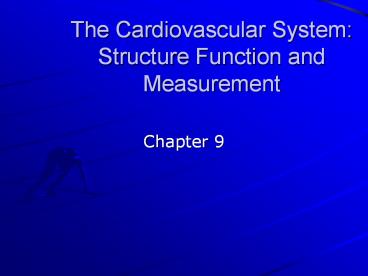The Cardiovascular System: Structure Function and Measurement - PowerPoint PPT Presentation
Title:
The Cardiovascular System: Structure Function and Measurement
Description:
The Cardiovascular System: Structure Function and Measurement Chapter 9 Organs of the Cardiovascular System Heart Blood vessels Arteries Arterioles Capillaries Veins ... – PowerPoint PPT presentation
Number of Views:1048
Avg rating:3.0/5.0
Title: The Cardiovascular System: Structure Function and Measurement
1
The Cardiovascular System Structure Function and
Measurement
- Chapter 9
2
Organs of the Cardiovascular System
- Heart
- Blood vessels
- Arteries
- Arterioles
- Capillaries
- Veins
- Venules
3
The Heart
- Muscular organ the size of a fist
- Four chambers L/R Ventricles L/R Atria
- Endocardium- lines the heart chambers
- Myocardium- muscle layer
- Pericardium- membranous outer covering
4
Atria
- Right Atrium (RA)- right upper chamber- receives
blood from body- deoxygenated blood - Left atrium (LA)- left upper heart.- receives
oxygenated blood from lungs and sends it to the
left ventricle
5
Ventricles
- Right ventricle- (RV)- right lower chamber-
receives blood from right atrium and sends it to
the lungs through pulmonary artery - Left Ventricle (LV)- lower left chamber- receives
blood from left atrium and sends it through the
aorta to the body.
6
- Aorta The main trunk of the systemic arteries,
carrying blood from the left side of the heart to
the arteries of all limbs and organs. - Pulmonary Artery carries blood to lungs
7
Mitral Valve
- Tricuspid valve controls blood flow between the
right atrium and ventricle - Mitral valve controls blood movement between the
left atrium and ventricle
Left Atrium
Right Atrium
Left Ventricle
Right Ventricle
Tricuspid Valve
8
- Pulmonary valve controls blood movement from
right ventricle into pulmonary artery - The aortic valve controls blood flow from the
left ventricle to the aorta
9
Arteries
- Arteries- tubes that carry blood away from the
heart. - Muscular elastic walls
- Form arterioles which form capillaries
- Carry blood and oxygen to the body cells
10
Coronary Arteries
- Supply blood to the heart muscle.
- The heart needs a large amount of blood and 5-7
of blood flows through the coronary arteries.
11
Veins
- Veins- tubes that carry blood toward the heart
- Thinner muscular walls
- Carry blood back to heart
- Cuplike valves to help move blood
12
Capillaries
- Capillaries- tubes that connect arteries and
veins - Walls only one cell thick
- Site for exchange of nutrients and oxygen from
blood cells and carbon dioxide and wastes to the
blood
13
Blood
- The body contains 4 to 6 quarts
- Contains Plasma antibodies, nutrients, gases,
waste products - Produced in bone marrow
- White and red blood cells
14
(No Transcript)
15
Measuring Cardiac Function
- Blood Pressure
- Electrocardiogram
- Stress Test
- Angiography
16
Blood Pressure
- Measure of fluid pressure within system
- Systolic Pressure Pressure generated by
contraction - Diastolic Pressure Pressure achieved between
contractions.
- SBP reflects the amount of work the heart is
performing - DBP indicates the amount of peripheral resistance
encountered - Arterial pressure increases with age, DBP more
than SBP - With aging, major blood vessels increase in
rigidity
17
Electrocardiogram
- Measure of the electrical activity of the heart
18
Stress Test
- ECG during exercise
19
Angiography
- Cardiac catheterization
- Inject dye into heart
- X-ray to examine blockages































